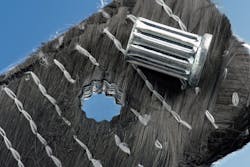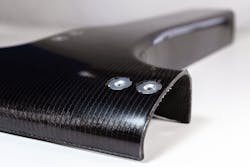Carbon fiber-reinforced plastics (CFRPs) are a versatile composite construction material that combines the positive mechanical properties of their constituent parts to offer high strength, high stiffness, and low density. Recognizing this, the Fraunhofer Institute for Laser Technology (Fraunhofer ILT; Aachen, Germany) is seeking to answer why CFRPs are still struggling to achieve a real breakthrough at a time of increasing concerns about energy and resource efficiency. In doing so, they have found that CFRP components have high production costs and are difficult to machine and process.
In March 2017, Fraunhofer ILT embarked on a project with four partners under the heading “CarboLase – Highly productive, automated and tailor-made just-in-time CFRP component manufacturing,” with the goal of helping to establish the subject matter experts involved in the project as technology leaders and boost their long-term competitiveness on both the national and international stage. The project partners achieved this goal by simplifying the CFRP production process chain and reducing costs.
The conventional way of assembling CFRP components is to drill holes in the fabricated CFRP module and then glue in metal fasteners such as threaded inserts. Replacing conventional parts with lightweight components requires connections between the CFRP part and the conventional parts that are both detachable and secure.
The CarboLase project pursued a different approach by integrating the fasteners in the textile preforms. The final CFRP is then produced with an additional curing process that includes the fasteners. This can significantly shorten production process chains. However, this method only works if the cut-outs for the fasteners in the textile preform are drilled with extreme precision.
The CarboLase project team developed a CFRP component manufacturing process that offered a three-pronged approach of CNC cutting, laser processing, and automated handling combined in a single robot cell with all the steps in between automated. First, the preform is created by cutting, stacking, and assembling the textiles. Next, an ultrashort-pulsed (USP) laser drills high-precision cut-outs in the preforms for the metal fasteners.
The USP laser offers a good alternative to conventional manufacturing, but only if the laser is integrated in the robot cell. Experts from Fraunhofer ILT and Amphos (also in Aachen) worked together to develop a novel technology for coupling the USP laser beam in and out. The USP laser source is connected to the scanner on the robot arm via a hollow-core fiber.
To test and demonstrate the process technical feasibility, the project partners produced a demonstration on a auto B-pillar component and subjected it to extensive mechanical testing, which it passed with flying colors. In a series of both pullout and torsion tests, the joints produced using the CarboLase method performed better than those in CFRP components produced by conventional means. The interlocking connection between the inserts and the matrix material can withstand a maximum pullout force up to 50% higher than conventionally manufactured components with glued-in inserts. This improvement in mechanical performance offers the potential to reduce overall component thickness and weight in selected components.The CarboLase method offers designers considerably more creative freedom when it comes to defining fastener size and position. This can lead to efficient mass customization of CFRP components that goes beyond the current state of the art. The dynamic USP laser drilling process is of particular interest for lightweight components in the aerospace and automotive sectors, offering the potential to reduce the process and material costs of CFRP component manufacturing.
Fraunhofer ILT, Amphos, and system integrator Lunovu (Herzogenrath, Germany) set up a robot cell at the Institut für Textiltechnik (ITA) at RWTH Aachen. Kohlhage Fasteners (Neuenrade-Küntrop, Germany) devised a system for the automated deployment and integration of the inserts. ITA took charge of implementing the automated process chain for manufacturing laser-machined preforms. The project received some-2 million euros of funding from the European Regional Development Fund (ERDF) over a two-and-a-half year period.
For more information, please visit ilt.fraunhofer.de.
Source: Fraunhofer ILT press release – January 30, 2020
Got laser processing-related news to share with us? Contact David Belforte, Editor in Chief, Industrial Laser Solutions
Get even more news like this delivered right to your inbox

